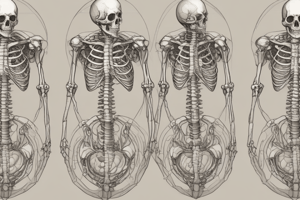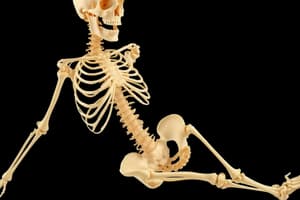Podcast
Questions and Answers
Which component of the skeletal system is primarily derived from the lateral plate mesoderm?
Which component of the skeletal system is primarily derived from the lateral plate mesoderm?
- Bones of the skull
- Vertebrae
- Ribs
- Bones of the upper limb (correct)
What is the origin of the mesenchyme, that directly differentiates into bone during intramembranous ossification?
What is the origin of the mesenchyme, that directly differentiates into bone during intramembranous ossification?
- Dermomyotome cells
- Mesenchyme in the dermis (correct)
- Sclerotome cells
- Neural crest cells
Which of the following structures is NOT derived from the paraxial mesoderm?
Which of the following structures is NOT derived from the paraxial mesoderm?
- Rib cage
- Bones of the lower limb (correct)
- Vertebrae
- Skull bones
What specific process do somites undergo to form the vertebrae?
What specific process do somites undergo to form the vertebrae?
What is a key difference between intramembranous and endochondral ossification?
What is a key difference between intramembranous and endochondral ossification?
From which germ layer are the cells that form the bones of the face and skull directly derived?
From which germ layer are the cells that form the bones of the face and skull directly derived?
What cellular differentiation process is directly involved in the formation of a hyaline cartilage model, which is then ossified?
What cellular differentiation process is directly involved in the formation of a hyaline cartilage model, which is then ossified?
Which of the following is not a part of a typical vertebra?
Which of the following is not a part of a typical vertebra?
Flashcards
Skeleton: Axial vs. Appendicular
Skeleton: Axial vs. Appendicular
The axial skeleton includes the skull, vertebrae, ribs, and sternum. The appendicular skeleton includes the bones of the upper and lower limbs.
Skeletal System Development: Sources
Skeletal System Development: Sources
The skeletal system develops from three sources: paraxial mesoderm, lateral plate mesoderm, and neural crest cells.
Paraxial Mesoderm: Role
Paraxial Mesoderm: Role
Paraxial mesoderm forms the somites, which contribute to the formation of the skull, vertebrae, and ribs.
Lateral Plate Mesoderm: Role
Lateral Plate Mesoderm: Role
Signup and view all the flashcards
Neural Crest Cells: Role
Neural Crest Cells: Role
Signup and view all the flashcards
Bone Ossification: Intramembranous vs. Endochondral
Bone Ossification: Intramembranous vs. Endochondral
Signup and view all the flashcards
Vertebrae: Structure
Vertebrae: Structure
Signup and view all the flashcards
Sclerotome Cells: Migration and Resegmentaion
Sclerotome Cells: Migration and Resegmentaion
Signup and view all the flashcards
Study Notes
Skeletal System Development
- The skeletal system is composed of the axial skeleton (skull, vertebrae, ribs, sternum) and the appendicular skeleton (pectoral girdle, pelvic girdle).
Skeletal System Origins
- Paraxial mesoderm: Forms the skull, vertebrae, and ribs.
- Lateral plate mesoderm: Forms upper and lower limb bones, costal cartilage, and sternum.
- Neural crest cells: Contribute to skull and face bones.
Paraxial Mesoderm Development
- Forms somites, crucial for skeletal development.
- Occipital somites and somitomeres form parts of the skull.
- Somites divide into sclerotome (forming bone) and dermomyotome.
- Sclerotome cells become mesenchyme (embryonic connective tissue).
- Mesenchyme differentiates into bone-forming cells (osteoblasts), cartilage-forming cells (chondroblasts), and fibroblasts.
Lateral Plate Mesoderm
- Forms bones of the shoulder, pelvic girdles, and appendicular skeletal parts.
Neural Crest Cells in Skeletal Development
- Neural crest cells differentiate into mesenchyme in the head.
- These mesenchyme cells form crucial skull and facial bones.
Bone Ossification
- Intramembranous ossification: Mesenchymal cells directly differentiate into bone.
- Endochondral ossification: Involves a cartilage model that is replaced by bone. Most limb bones and base of the skull follow this method.
Vertebrae Formation
- Vertebrae develop from sclerotome components of somites (paraxial mesoderm).
- Composed of a body, arch, foramen, transverse, and spinous processes.
- Sclerotome cells migrate and merge during the fourth week.
- Somites undergo resegmentation during this period.
Studying That Suits You
Use AI to generate personalized quizzes and flashcards to suit your learning preferences.




